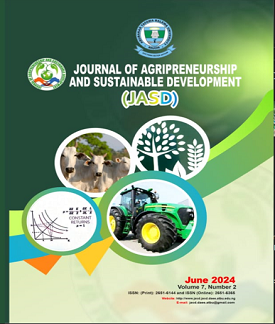DROUGHT STRESS TOLERANCE OF GREEN MAIZE (Zea mays L.) VARIETIES AS INFLUENCED BY SEED PRIMING AGENTS, DURATION AND CONCENTRATION
DOI:
https://doi.org/10.59331/jasd.v7i2.762Keywords:
Agents, Chlorophyll, Concentration, Green, TemperatureAbstract
Two experiments (screen house and open field) were conducted at the Research and Teaching Farm of the Department of Agronomy, Bayero University, Kano, Nigeria (Lat 11°58’N, Long 8°25'E, and altitude of 475 m asl) during the 2019 dry season. The open field trials were undertaken between March and May 2019, while the screen house trial was carried out between August and November 2019. The treatments consisted of two varieties (SAMMAZ 15 and SAMMAZ 17), five priming materials (cow dung, poultry dropping, CaCl, KCl, and distilled water), five priming durations (2, 4, 6, 8, and 10 hrs), and two concentration levels (2 and 4%), all fractionally combined to give 100 treatments. The design used was a fractional factorial design in 60 incomplete blocks. The treatments were assigned to the blocks using the design of the experiment platform of JMP version 14 software (SAS Institute Inc..) according to the D-optimality criterion for an ANOVA model that has the main effects of priming agents, priming duration, and priming concentration, including all their 2nd order interactions and a random effect of three replications. The findings from the study show that seed priming, regardless of the priming agent, duration, or concentration used, did not generally have a significant impact on most measured parameters in either open field or screen house environments. However, the positive impact of 2% KCl priming on cob yield in the open field suggests it might be a beneficial strategy for mitigating the adverse effects of drought. In general, on-farm seed priming of maize seeds with KCL can enhance the growth and yield characteristics of the plant while assisting the seedling to withstand drought at the lowest feasible cost.
Downloads
Downloads
Published
How to Cite
Issue
Section
License
Copyright (c) 2024 Journal of Agripreneurship and Sustainable Development

This work is licensed under a Creative Commons Attribution 4.0 International License.







